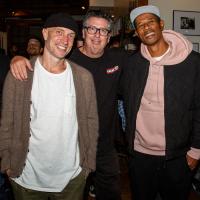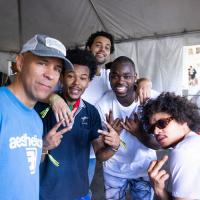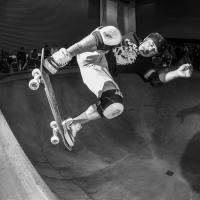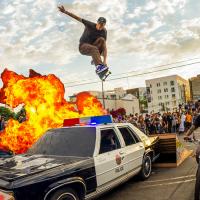Alphonzo Rawls: 30 Years of Skate and Art Innovation
9/11/2020
 Alphonzo Rawls is one of those people who is seemingly great at everything he tries. Dig a little deeper, though, and you’ll find that his many accomplishments aren’t just the result of talent or luck—he’s a fearless innovator, always down to try new things, test himself and keep exploring. While the transition from being a pro is a hard one for many, Alf’s curiosity and drive has allowed him a life in skateboarding on his own terms. Not that he doesn’t still rip. Seriously, dude will smoke your ass on any quarterpipe.
Alphonzo Rawls is one of those people who is seemingly great at everything he tries. Dig a little deeper, though, and you’ll find that his many accomplishments aren’t just the result of talent or luck—he’s a fearless innovator, always down to try new things, test himself and keep exploring. While the transition from being a pro is a hard one for many, Alf’s curiosity and drive has allowed him a life in skateboarding on his own terms. Not that he doesn’t still rip. Seriously, dude will smoke your ass on any quarterpipe.Once you found skateboarding, what artwork really jumped out at you?
I would have to say it was Powell-Peralta’s artist VCJ—Vernon Courtlandt Johnson. That was the most intriguing artwork to me when I first started skateboarding. Actually, he’s still my favorite artist to date. I liked the detailing that was in his work.

Pretty soon into your skate career you were able to do some graphics. What was the first graphic you made that got put into production and who was it with?
When I got sponsored for skateboarding, not only was that the beginning of my skate career but that was actually the beginning of my art career as well. It was something that was kind of birthed simultaneously, because being able to get a sponsor skateboarding also gave me a platform in which to present the artwork that I was doing. One of the first art pieces I did that got put on a board was for H-Street and it was my own personal pro model which featured the Pillsbury Doughboy with a finger coming in to press him in his stomach just like the old commercials from the ’80s and ’90s. Where I came up with that idea, I don’t really know. I think the character in itself was appealing to me. I grew up being intrigued by cartoons and stuff like that so it felt like that character was just graphic-friendly. Outside of that, I don’t know if there’s even a bigger explanation other than the fact that those commercials were on all the time and I just liked that character.
 When did you get organized with your materials, or were you just a magic-marker doodler?
When did you get organized with your materials, or were you just a magic-marker doodler?I never really got organized with my art because I’ve always explored with tons of different mediums—from markers, paint to spray paint. I love markers and colored pencils but I’ve always gone from medium to medium. I did a lot of paint-pen art back in the day as well and one of the paint-pen pieces that I did was of an NWA cover that ended up being used for a slick-bottom board that I had back in the ’90s. So, a lot of the artwork that’s presented to you today, it spans a whole bunch of different mediums. So I’m not really organized. I come up with an idea and then I use whatever medium best suits the concept.
So coming out of the ’80s, skateboarding was still really, really white. H-Street had you, Ron Allen, Sal Barbier, John Reeves and Sean Sheffey. Did it feel different? Were you conscious of having this more diverse team?
Actually, I was. I was more conscious of it because I felt like our team was more diverse than some of the other teams back in the day. Because, like you mentioned, there weren’t as many Black skateboarders back in those days. And so the fact that I got to share a team with Sal Barbier, Ron Allen, John Reeves and some guys that looked like me, it definitely gave me more of a home feeling of really being comfortable with the team that I was on. There definitely was a feeling of diversity with the H-Street team.
 Back Smith cover from a simpler time. Nov., 1992
Back Smith cover from a simpler time. Nov., 1992Where did that come from? Was that something that happened organically or was there somebody actively looking to get a more diverse team?
No, that more or less happened organically. Mike Ternasky was good at scouting talent and also H-Street was in such a position where people desired to ride for the brand. So a lot of the most talented dudes would find their way to H-Street or be in front of the right people to get on the team. But that wasn’t anything that was on purpose. And then also, on the subject of race and racism and H-Street, Mike Ternasky was really vocal in making me somewhat the face of anti-racism. In Next Generation, the song he selected for me and some of the narrative that I spoke to in my video part was such an awesome thing. In hindsight, he positioned the narrative and the way it came out.
A true renaissance man, check the credentials with his 1992 Next Generation part
H-Street was kind of this hot bed of progression for a while. You guys knew you weren’t the Bones Brigade and I remember even hearing rumors that the old guard was kinda bummed. You brought a lot of tricks up from mini ramps, which the old guard, they learned in the concrete pools first so they had a problem with that. Do you remember getting push back from the establishment as far as what you guys were doing?
Yeah. I mean, not everybody liked H-Street, right? The competitive nature of just even being that age and the different companies and going to contests and stuff like that, there were some unofficial rivalries. I remember having a little bit of a conflict with the Dogtown team of the early-’90s where they were kind of anti us and anti H-Street tricks and all the new things that we were doing. But I think that a lot of it was due to the competitive nature of what we were doing. As a part of waving your own flag, you have to have somebody you identify as the antithesis of what you’re doing. So we were that to a lot of brands, I guess.
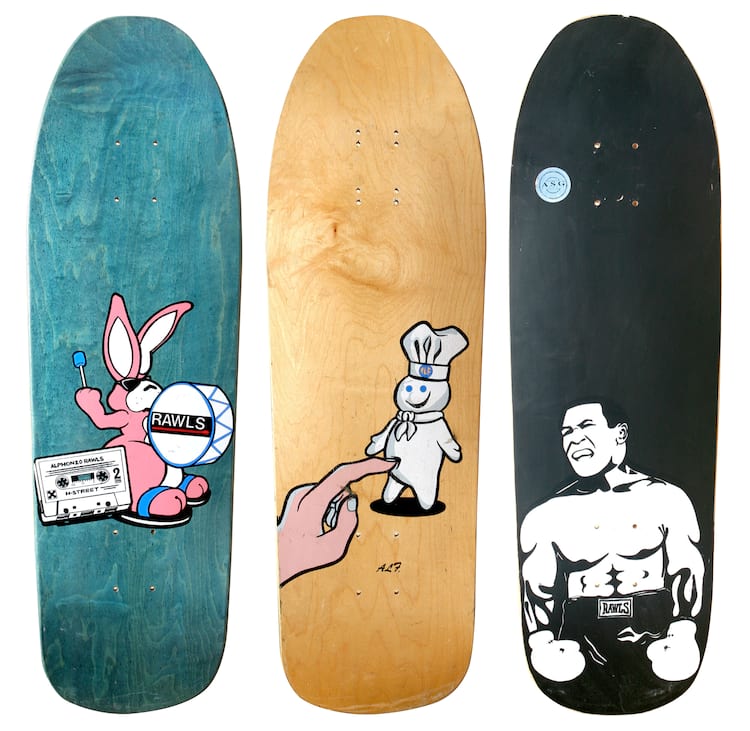 Some classic H-Street graphics by Alf. Board photos courtesy of @seancliver
Some classic H-Street graphics by Alf. Board photos courtesy of @seancliverSo when you rolled up was it a bad feeling or did you guys feel like badasses?
Personally, I felt badass because there was no team that I would rather have rode for. With my style of skateboarding, being a part of H-Street felt like a perfect match. Any time you disrupt an industry in that way there’s going to be pushback from people who are either jealous in some way or don’t completely approve of what you’re doing because it’s different from what they’re doing.
H-Street was heavy on new tricks. What was your train of thought then when you were really progressing?
My train of thought was really identifying a lot of the moves we were doing on street and trying to take them to vert. Which was interesting because in the early days of skateboarding it was the street skaters taking what they saw on vert and applying it to street and curbs—hence the street plants. But what inspired me was the new guys who were coming up, the changing of the guard so to speak. Hensley, Gonz and stuff of that era—what they were dong. I was inspired by that and through the competitive nature of me and Danny and the fact that we skated together a lot, we’d have all these different ideas and we would really push each other to make it happen. So that was my kind of inspiration—taking a look at it and seeing what everyone was doing on street and mini ramps and trying to adapt those tricks to vert—like a lot of the flip tricks, a lot of the flip grabs and some of the curb-dancing type of things.
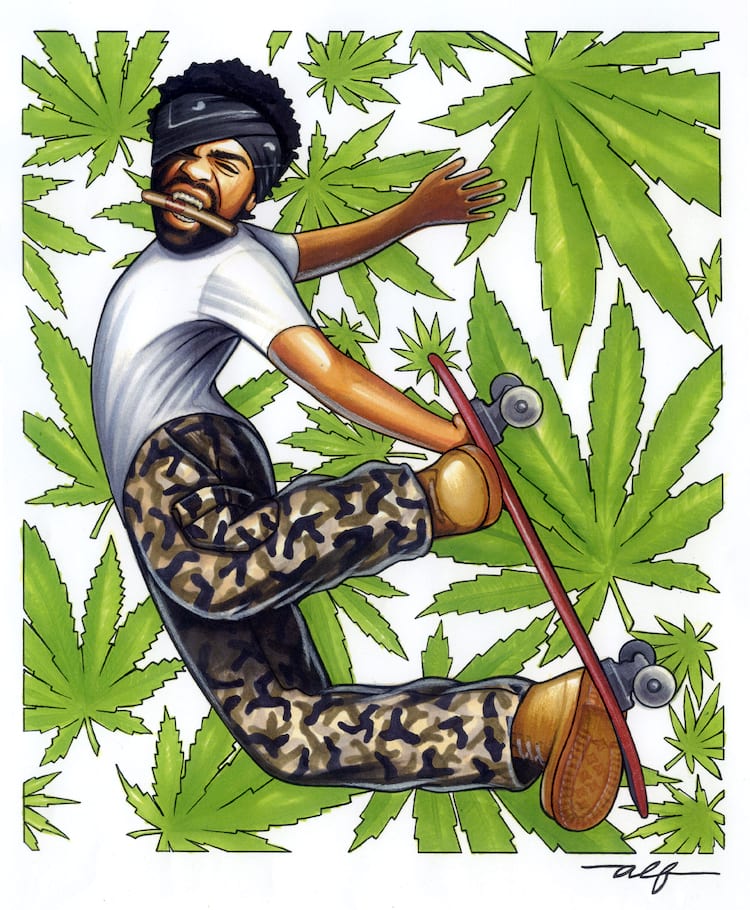 Pop culture, skateboarding and weed, Alf brings it all together with Everybody Skates
Pop culture, skateboarding and weed, Alf brings it all together with Everybody SkatesDo you remember any tricks that you feel like maybe you were one of the first guys to do it?
Yeah, those are always touchy subjects, right? There was definitely a good list of tricks that I didn’t reference from seeing it anywhere else before I decided to do it. Not to say that I invented it, but when I did backside tailslides for the first time on vert I didn’t really see anyone else doing them at the time. I think in the H-Street video was one of the first backside tailslides on vert that was documented. I did a trick that I think Andy Mac has taken a lot of credit for these days. I’m just joking, it’s fine, but the mute to melon 540s, I used to do that. I remember actually learning that at home laying down in my bed with a skateboard deck thinking like, Oh, this is possible. So I literally learned it in my mind. What I mean by that is I laid down, I went through the motions, I convinced myself exactly what the trick would feel like and how it would be done. I convinced myself that I’d already learned it so by the time I took it to the skatepark the following day I landed it within four tries. Yeah, so there was some stuff like that.
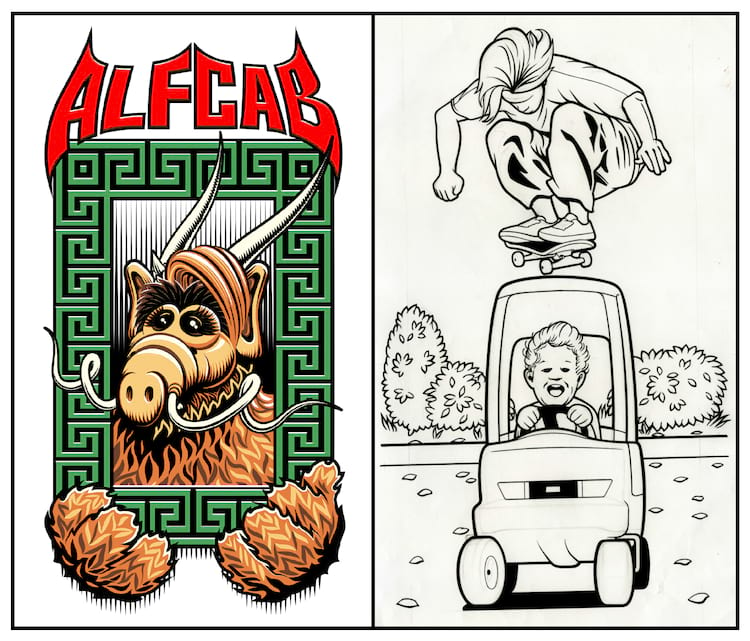 Era-blending homages for Everybody Skates and Plan B
Era-blending homages for Everybody Skates and Plan BYou had all the newest tricks, but you were never much of a contest guy, right?
You know what, I really sucked at contests. The nerves always got the best of me. I had a hard time getting it together during contests, getting relaxed enough and getting out of my own head. So yeah, if you wanted to come see me skate at the contest you better get there the day before and watch practice because you’d see me cruise around but I wouldn’t actually be in the contest after the cuts were made. But you know what, funny story about that—I sucked at contests, right? But when I first turned pro, I turned pro in San Jose at a mini-ramp contest and the deal for me to get a pro model was that I had to place top ten. Which in my mind I’m thinking like, Fuck, I’m never gonna have a pro model. There’s no way. But what ended up happening was that I skated the semifinals, didn’t think I’d made it so I was like, Fuck, okay, whatever. Better luck next time or some shit. I started eating nachos the way that I like them—with tons of jalapeños and all that stuff. So I hear them announcing the cut and as it turns out I made the cut, fuckin’ tenth place. So I’m sitting there with a gut full of jalapeños and shit at a San Jose mini-ramp contest and I’m excited but kind of tripping out at the same time, like Oh fuck, I done fucked my stomach up with all these nachos and jalapeños, but I ended up making the cut and placing exactly tenth place in that contest. And the deal was that in order to get a pro model from H-Street—this was a deal set forth by Mike Ternasky—I had to make top ten. I made exactly tenth place in my first pro contest and the Alphonzo Rawls pro model was born.
 Spine attack at Alf's first pro event Photo: Mofo
Spine attack at Alf's first pro event Photo: MofoHere’s a question the nerds want to know: how come you weren’t on Plan B?
A good year or so before they even finalized the deal, me, Mike Ternasky, Sal Barbier and a group of dudes were filming and Ternasky mentioned to me that he was going to be doing something new and he told me the name he had in mind. It was gonna be me, Danny and a few other people but then by the time the deal was finalized a year or so later I wasn’t a part of that. It wasn’t really by choice. I actually found out that Plan B was forming when John Sonner and I were on a Midwest tour from San Diego to New York and back. I think it was a couple weeks into that tour that we found out, Oh wow, these guys just pulled away and created their own brand. What’s it called? Plan B? And we go, Whatever. So we came home to a completely different scene. I think that kind of signified the end for some of the dudes who didn’t end up making it for Plan B. It was like H-Street at that point was no longer able to afford such a big team so some of the John Sonners and Aaron Vincents, some of those guys just ended up fizzling away after that happened.
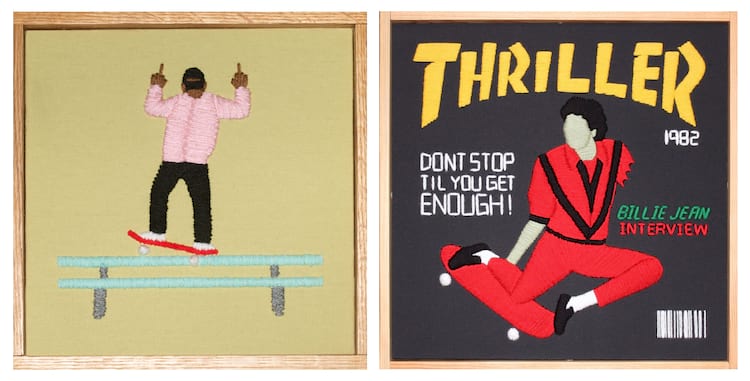 Mixing up the mediums with some Everybody Skates embroidery
Mixing up the mediums with some Everybody Skates embroideryWas that a heartbreaker to you?
It totally was because I related with Mike Ternasky so much. He was like the father figure that we didn’t have and the way that he interacted with us, you looked forward to being with him. He inspired you; he motivated you; you wanted to show off in front of him; you wanted to show him these new tricks that you learned. And then on top of that I’d gotten on H-Street originally because of Danny Way. We vibed really well together so the fact that we were no longer on the same team, it took a little wind out of my sails. And it was clear when you take such a big powerful chunk out of a team, that team isn’t going to be the same anymore. So it was definitely a heartbreaker at that time and at that age. Being on a team that you’re proud of because it had all of these people and then all of a sudden having that chunk leave and go somewhere else, I can’t lie, it sucked.
So what did you do artwork-wise after that? What was your next big thing that you invested time into creating after those first H-Street boards?
I still ended up doing more art for H-Street after Plan B broke away. H-Street became Evol at that point, which is love spelled backwards. So I was still really involved, even more so doing graphics with Niko Achtipes who was their creative director at the time. In addition to that I was also riding for Droors clothing which was run by Danny Way’s brother and Ken Block who later formed DC shoes. With Droors I was afforded some cool opportunities to do some graphics for them as well as advise on some apparel-design stuff. So I was able to keep that creative flow going through some of the other sponsors that I was working with at the time. And DC being a strong up-and-comer was really making a lot of splash at that time.
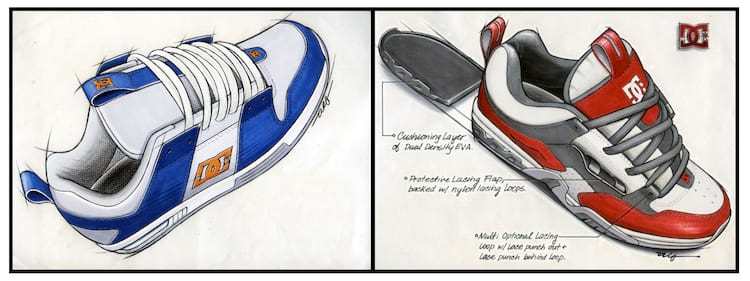 Possibly the techest shoes ever drawn by hand
Possibly the techest shoes ever drawn by handWas this the dawn of the computer age? Did you step to an early CorelDRAW?
I knew things were heading in that direction but I was just so intimidated to even begin learning how to use the computer. I knew the importance of having a computer and so I bought one and it sat on my desk for two years. I never really fucked with it. I didn’t even surf the web on it. It wasn’t ’til I started working with DC Shoes in early 2001 when they had begun submitting tech packs via Adobe Illustrator. Before that everything was all hand done. And so me falling into an opportunity to design with DC Shoes forced me to learn the computer and learn the programs that they were designing on. So it was nerve racking. So what ended up happening was one of the junior designers there spent about a half hour with me teaching me Illustrator. After that half hour I knew enough about Illustrator to learn everything else. It gave me the basis in which to figure everything else out. But it wasn’t ’til like 2001 when I really got heavy into designing using the computer. Then from there I started implementing a lot of my creative art designs into Illustrator and Photoshop.
Is there anything that we’re missing from Evol to the DC job as far as artwork? Because also the transition from pro skater to not pro skater is very difficult for some people, but you almost had this second boom when you were on Expediton. Because back then you just went off the videos or the magazines. You didn’t really know what was coming and it was like, Oh well, he’s not on Plan B. Maybe he’s gone? Then the next thing you know you’re nosesliding 16-stair rails.
Let me digress for a second because it kind of relates to what we were talking about before about what my feelings were after the dudes from Plan B peeled away. Like I mentioned, that was a pretty big blow. I was so motivated to ride for H-Street because of all of the parties who were involved. It really made me feel like a part of this innovative crew of dudes who were doing the most, pretty much, in the industry. So after those guys peeled away and started doing Plan B, I was really unmotivated for the longest time. I would go months without skateboarding. Then when I’d go to skate I would go strictly to film tricks and that was it. Outside of that I wasn’t really skating much. If I had an idea for a trick, I’d go film it or get it done and that was just kinda it until we started Expedition. When we started Expediton I was really inspired again because that was my and Chris Lambert’s baby. It was like we had to pull our weight; we had to make it different. We just paid for a fuckin’ six-page ad, we damn well better do something to support that. So it was that feeling of being reinspired and remotivated that was the birth of me doing a lot of the handrail stuff, a lot of the newer handrails and bigger stunts that I was doing later on in my career. Basically we were launching a brand and we needed to present the excitement that we were trying to market with the brand. So once that got going it kind of fired me up to really give a good effort of really trying to be more impactful again. From the beginning of Plan B ’til that time, all of the in-between space was just really uninspired, unmotivated, just more or less doing as little as I could get away with, to be perfectly honest with you, and still get paid to skate. But I wasn’t as inspired. It started feeling like a job. And then, you know, being that age, it’s like you start finding other interests, whether it’s cars or girls—any other things that would occupy your time that would otherwise be allocated towards skateboarding and everything involved with skateboarding. So I was distracted and highly unmotivated for the period after Plan B to the beginning of Expedition.
This noseslide is just as crazy now as it was in 2001, revisit Alf's Alone part for Expedition
Did you have a hand in the branding of Expedition?
Me and Chris Lambert started Expedition. My friend Dave Kinsey, who was responsible for the DC logo, he did a lot of the creative direction and the graphics for it at the beginning. So I didn’t do too much graphics at that time, I was just focused on skateboarding, filming, doing all of that stuff and Dave was an awesome artist who really handled a lot of the creative responsibilities at that time.
 Looking at your current stuff, you’ve obviously got some heavy illustration chops. How did that develop?
Looking at your current stuff, you’ve obviously got some heavy illustration chops. How did that develop? By surrounding myself with information, keeping myself inspired and motivated. Just like skating, if you’re interested, you study it and you are seeing what other people are doing, you start adapting and you start being ingrained in how to do stuff. It’s the same way where I explained how I convinced myself that I learned a trick just by laying down and envisioning it. It’s the same thing with art. If you’re really inspired by art where you’re surrounding yourself with a lot of that visual stimulation of different artists doing different things, you pick up on these different little details and techniques and you’re then able to apply that to your work, having all of these references that you’ve already engaged with.
So have you just drawn consistently since you were a kid?
I’ve been drawing longer than I’ve done anything else, longer than I’ve been skating or breathing air for that matter. Like I said, it was birthed from just a short-attention-span type of thing. Anytime I started drawing something I always focused and homed in on a project. So it was just born from that, just born from a short attention span and the intrigue. Here’s the thing that really explains my personality—it’s like I’m intrigued in anything creative, something that you can produce that was once just an idea. And then from there you figure out all the little nuances on how to turn that idea into a reality. Whether it’s carving wood, making furniture, sculpting something, illustrating and drawing or painting, I’ve always been intrigued by the ability to have an idea and then make that idea a reality.
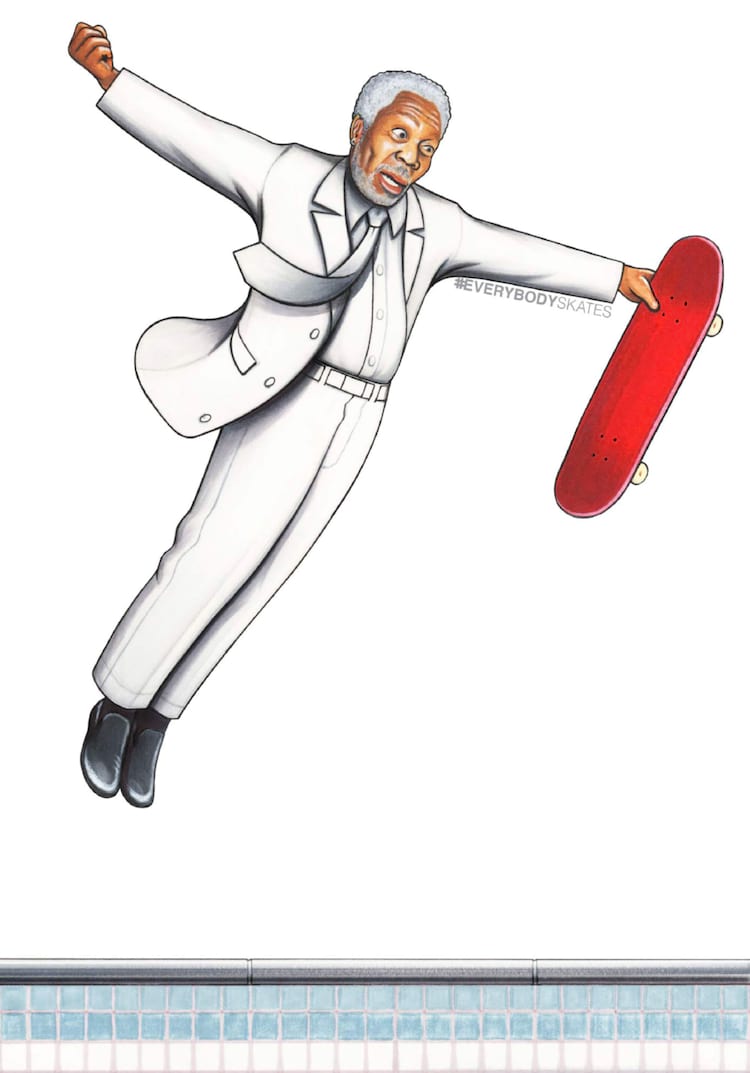 The Father of Christ air, of course Morgan Freeman would have proper form
The Father of Christ air, of course Morgan Freeman would have proper formWhen was the moment where you were like, What do you know, maybe I’m not a pro skater anymore, maybe I’m a professional artist/designer?
In 1995 I got an opportunity through an upstart footwear brand by the name of Kastel shoes. They approached me to have a signature shoe and they gave me the opportunity to design it. Me being into all things creative and fashion and stuff like that, it was right up my alley. I was just thrilled to death at the opportunity not only to have a signature shoe—because let’s be real. I mean, I’m being real with myself. I could name a million people at the time who were more deserving of the opportunity, but the fact that I got the opportunity, I was thrilled as all hell to be able to do that. Not only just to have a signature shoe, but it meant that I was able to create in this way. It was giving me another medium in which to create. So engaging in that process of footwear design, I really loved the process and at the end of it I ended up submitting like ten designs when I was supposed to just submit one. But I couldn’t land on only one design that I liked. So I got my pro model and I also came up with six designs that they ended up using in their footwear line. And so, being really intrigued by the process, a lightbulb went off in my mind during the process of designing my first signature shoe and it allowed me to identify what my aspirations after skateboarding were. Having that opportunity kind of cleared the path to be able to pursue that. So after I left Kastel I landed at Duffs shoes who had given me the same opportunity as Kastel did but they were going to invest in my education of footwear design a little more. They would allow me to do all of the production travel and get that firsthand education on footwear design, conscription and development and all of that stuff. So I knew after designing my first shoe what I wanted to do after skateboarding. That opportunity informed what my pursuit was going to be after skateboarding. It kind of just spawned from there. From Duffs I was afforded an opportunity when a group of dudes had left from DC to go start Lakai shoes and Clae footwear. That left a gap that needed to be filled at DC and so I was able to come in to DC and be one of the head designers there and the rest is kind of history. Because with DC in your portfolio you’re able to then legitimately get work. I’d created a buzz by that time working with DC with all the shoes that I designed for them at the time and I was getting approached by different footwear manufacturers to do designs for them. So I was afforded an awesome opportunity not to have to figure out how to transition out of skateboarding because I was still skateboarding when I was transitioning into footwear design.
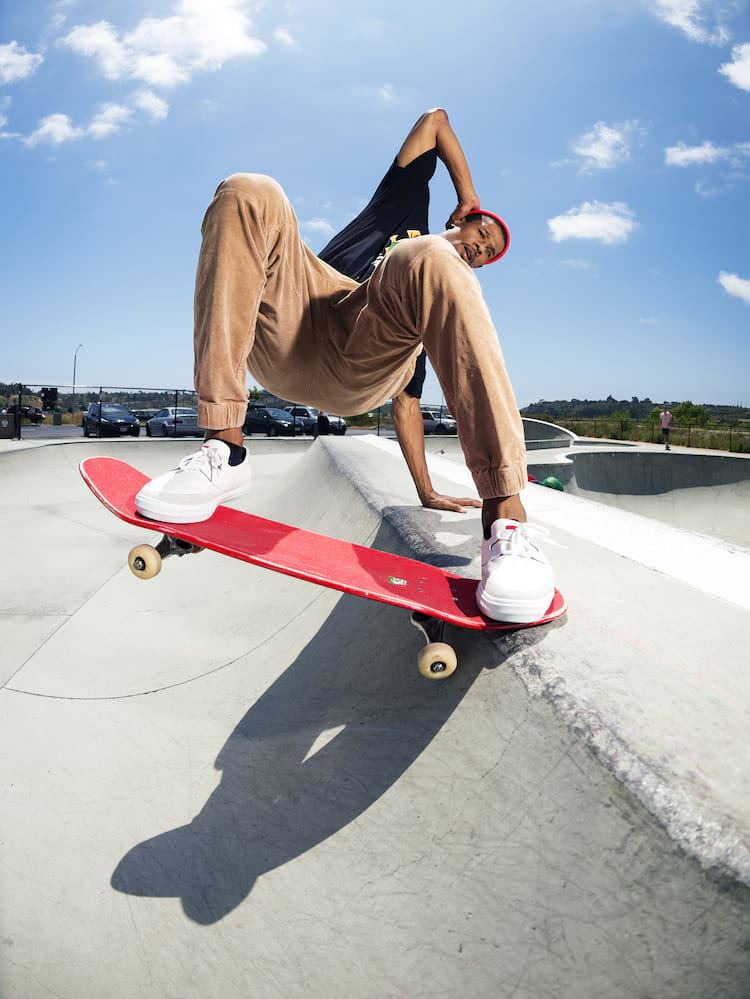 Master of transitions, Alf takes a laid-back screen break
Master of transitions, Alf takes a laid-back screen break So when you talk about the production, travel and stuff, you went all the way from probably just drawing something freestyle on a piece of paper to learning the computer applications as they developed to actually traveling to the factories and seeing the materials. So that’s a pretty incredible education. So for people to think like, Oh what, you just draw a dope shoe? It’s way more involved than that, especially as the technology has changed, right?
For sure. And that was me too. Before I got the opportunity through Duffs of really exploring the production and the development of footwear, I just had cool ideas. I didn’t know if those cool ideas worked or not and it wasn’t until I was afforded that education of actually going and checking out the factories, checking out the tanneries, checking out where the molds are made that gave me a clear understanding of not only the process but what was possible or not. So I was able, through that education, to understand why it was that some of the designs that I was submitting prior to getting that education weren’t possible and didn’t really translate. So that was definitely an important eduction for any footwear designer to have, is to understand how the footwear is made and from there it’s gonna inform what your limitations are. ’Cause like I said, my early days before that, I was coming up with a whole bunch of designs that were getting rejected when I would submit them to the factory without having a clear understanding that informed me as to what was possible or not.
 A less clever illustrator might've made Will Smith
A less clever illustrator might've made Will SmithSo what are some of your greatest hits as far as skate shoes that people might know?
When I was working with DC in those early days they kept me busy and in a year’s span I probably created about 30 models that they ended up manufacturing, one of them being the Lynx HE. I don’t know if you’re familiar with the original Lynx model, but that was popular for DC and they were looking for an update. I created the Lynx HE which was a version two of the original Lynx that was really popular. You hear a lot of comments how that was a lot of people’s favorite shoes back then. Also for DC I created the Court Graphic which is the basic shoe, minimal paneling, with the big DC logo on the heel. It didn’t take a design genius to design that, but it was the forecasting of big logos and stuff like that becoming a new thing, especially where DC was positioned as a brand at that time. A lot of the big graphics that they had on their t-shirts were doing well, so it was kind of forecasting the idea that people wanted big logos. So the DC Court, the Lynx HE, I designed a snowboard boot called the Arch for DC, as well. I designed one of the Kalis pro models. One of my first projects for DC when I came on board in 2001 was Stevie Williams’ second pro model. I know I’m leaving tons out but I was damn busy working for them and the deal was great because they gave me a good salary and I also made royalties off of those shoes. Colin Mckay’s shoes, I forget the names of these shoes. I’ve been designing and developing footwear for the last 25-plus years and so in that time I’ve produced well over 100 manufactured footwear designs and I’ve worked with over 30 footwear brands.
 So after all that you still circled back and probably never left these illustration types of projects. You have Everybody Skates, you have this cool embroidery stuff that you’re doing. Talk about jumping from medium to medium and project to project and what’s gotten you excited about these different things.
So after all that you still circled back and probably never left these illustration types of projects. You have Everybody Skates, you have this cool embroidery stuff that you’re doing. Talk about jumping from medium to medium and project to project and what’s gotten you excited about these different things.I’ve always been working on multiple projects at a time, so that’s been my process. You’re here in my house now looking at my desk and this is relatively clean, but you see footwear, you see art and stuff that I’ve done. I’m working on a few projects at once. So one tends to inspire the other. I’ll have a file open where I’m working on shoes and on the same laptop I’ll have the next Everybody Skates project and whatever apparel design thing that I’m working on. I’ve just always been all over the place and I feel like that’s the way that works best for me because sometimes when you home in on something too much you need to detach yourself from it and come back with a new perspective. So I feel like when I’m working on a bunch of different projects, it’s always a steady flow of inspiration. I’ve always gone from designing shoes to graphics. At one point I had a whole bunch of woodworking equipment in my garage and I would build furniture and shit. Like the ottoman that you see outside, I built that. The bed that I sleep on, I built that. I’m kind of scatterbrained that way. I was probably in the middle of designing tech packs and for DC Shoes when I came up with the idea for this ottoman. I just bounce back and forth with different mediums and different designs.
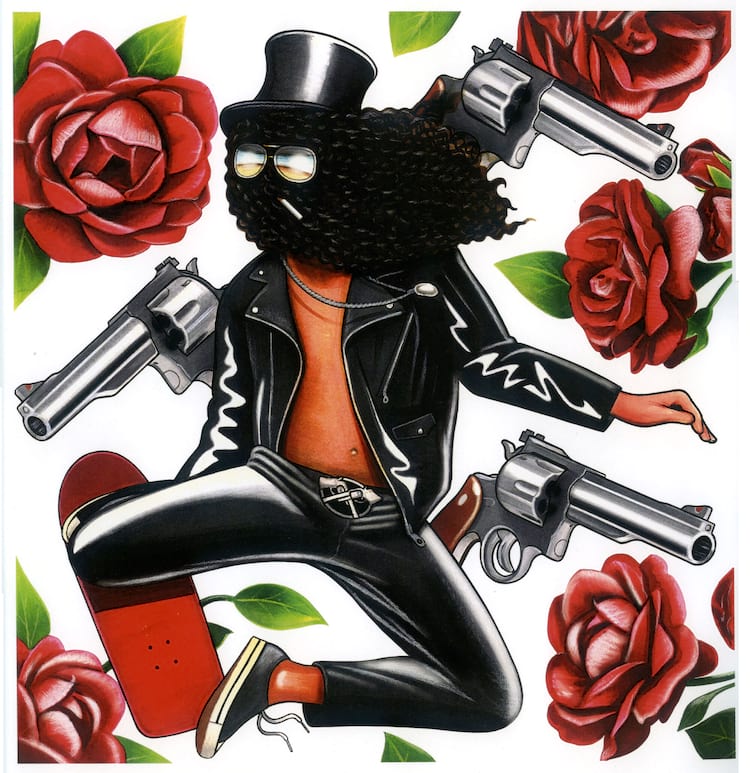 Always messing with expectations, Alf depicts Slash doing a mean method
Always messing with expectations, Alf depicts Slash doing a mean methodWhat’s been the process to getting to the latest version of the Thank You shirt that features the names of so many Black skaters?
The Thank You shirt was something I released about four years ago during Black History Month. I came up with the idea because I’m a Black guy in a prominently white industry. It’s becoming less and less white—well, it’s becoming more and more diverse, which is cool. But it was my idea a few years ago, basically in celebration of Black history ’cause it’s something I connect with. I think due to the social climate, me releasing it in the past couple of weeks is resonating even more with people and it really kind of began taking off. Being of Black culture, I’ve always tried to do special projects in line with Black History Month and that’s something that I did a few years ago. Due to the current social climate I was getting a lot of people DMing me and reposting the design that I did years ago and requesting that I offer it again. So I thought the timing was right and so I decided, you know, let me go ahead and re-release it. But since the design that I did was kind of old, my idea was to get engagement from my audience and be like, “Hey, here’s the shirt from a few years ago but I would like to update it.” So I encouraged my audience to give me names that they thought deserved to be on the shirt and it’s created this crazy little storm of people really excited about the project and people feeling like they were personally connected to it because of the process that I set up. It was like, “For the next few days give me new names that you’d like to see on the shirt.” Lots of people engaged and felt like they were a part of the project and it just really took off.
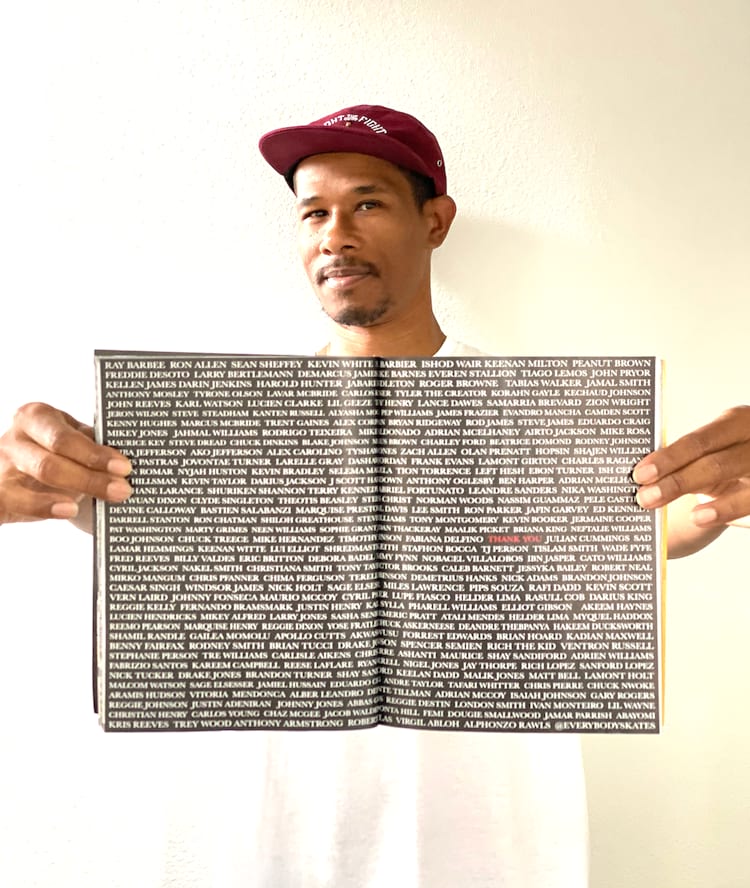 Two full pages and counting
Two full pages and countingHow many more names do you have to put on the next version?
I think this will be an ongoing project and it will consistently be updated every so often, every year or so. I’m currently working on a board project which means I had to come up with more names and that will hopefully cover most of everybody that anybody’s familiar with in skateboarding. But the hard thing about doing these projects is it’s always after you send it to the printer that you realize, Dude, I left this guy out. I forgot this guy. That’s always going to be the case and that’s kind of why I positioned it as something that’s gonna be an ongoing thing and we’re gonna continue to add names to it. At a certain point the idea is to get it where it’s a front-and-back thing to where there’s so many names that you can’t just have it in a small front print. So that was the idea. So if I can get it from where it is now to a front-and-back print and then at some point, shit, in the next five years I might have to fuck around and make long sleeves where I’ve got names down each sleeve.
 Another classic reimagined for the pioneer Peanut Brown
Another classic reimagined for the pioneer Peanut BrownWhat’s your professional life like these days?
I have to say I’m fortunate to be doing what I’m doing right now and I wake up every day, busy as hell, but I wake up thrilled ’cause I do what I love to do. I wear several different hats. One of them being I work for a Chinese footwear factory in Xiamen, and obviously they produce footwear. So what I do for them is I’m a broker which means I bring footwear production business to them. They are also investing in the upstart of a few different footwear bands, which I’m not only the designer, but I’m the creative director for a couple brands that we’ll be launching this year and next year for the factory that I work with. And they’re also looking to acquire a few footwear brands in the upcoming years, so I’m a consultant for those transactions. In addition to that I run my own company, Everybody Skates, which the fun thing about that is it’s kind of my side hustle but it’s the big thing that everyone identifies me with right now. I’m so passionate about what I do with Everybody Skates because it really just feels organic and it’s much less a company, I’d hate to say, than it is just an artist project. The latest exciting project that I’m a part of which is a footwear brand by the name of Sevalé. I’m creating a luxury footwear brand and we’re gonna offer real limited quantities of footwear, like maybe 200 pairs or less and I’m taking no shorts when it comes to attention to details with the product that I’m creating for this brand. I was fortunate for the past 30 years to be able to be a part of some really cool projects and design for some pretty cool brands but this project is different than any other. Because when creating a design for some of the other brands I was fortunate enough to work with, the creative direction was at the mercy of whatever the design brief was. With this new footwear product that I’m working on, I’m leading the charge on the creative vision of the designs. So it’s kind of a refreshing project from that standpoint. It allows my creative thoughts with no limitations. So I’m really excited. That’s my most exciting project that I’m launching right now. We should be launching it around September.
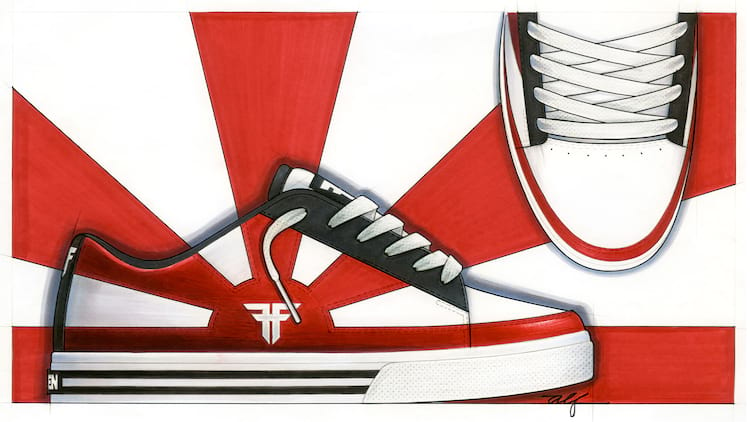 Rising Sun for Fallen, before the acquisition
Rising Sun for Fallen, before the acquisitionWho are some of your heroes?
Man, I have plenty of heroes. I would have to say Bruce Lee is definitely a hero of mine. Sal Barbier—it sounds funny to put his name in there but he really inspired me in a lot of my early days of skateboarding and being a part of H-Street and hanging out with him. I would definitely classify him as a hero and a lot of the early skateboarders before my generation—the Peanut Browns, the Steve Steadhams, I definitely look at those guys as heroes. And I don’t even know if heroes is the best term to use but I’m definitely inspired by them. I could qualify Mike Ternasky as one of my heroes. He’s one of the founders of H-Street and was a huge father figure to me. Oh, this probably should have been one of the first names that I said, but Tony Hawk. I love me some Tony Hawk, you know what I’m saying? At the time I started skateboarding I was a huge Powell-Peralta fan and loved the Bones Brigade and a big part of that was Tony—just his style of skateboarding being so innovative. New tricks and stuff like that, that’s what really inspired me and helped to shape a lot of what I did as a skateboarder. Being that skateboarding’s the biggest part of my life, he’s definitely one of my biggest inspirations in skateboarding. He could definitely be classified as a hero. And there’s Matt Hensley, there’s Sean Sheffey. I’ll remember all of the others as soon as you leave.
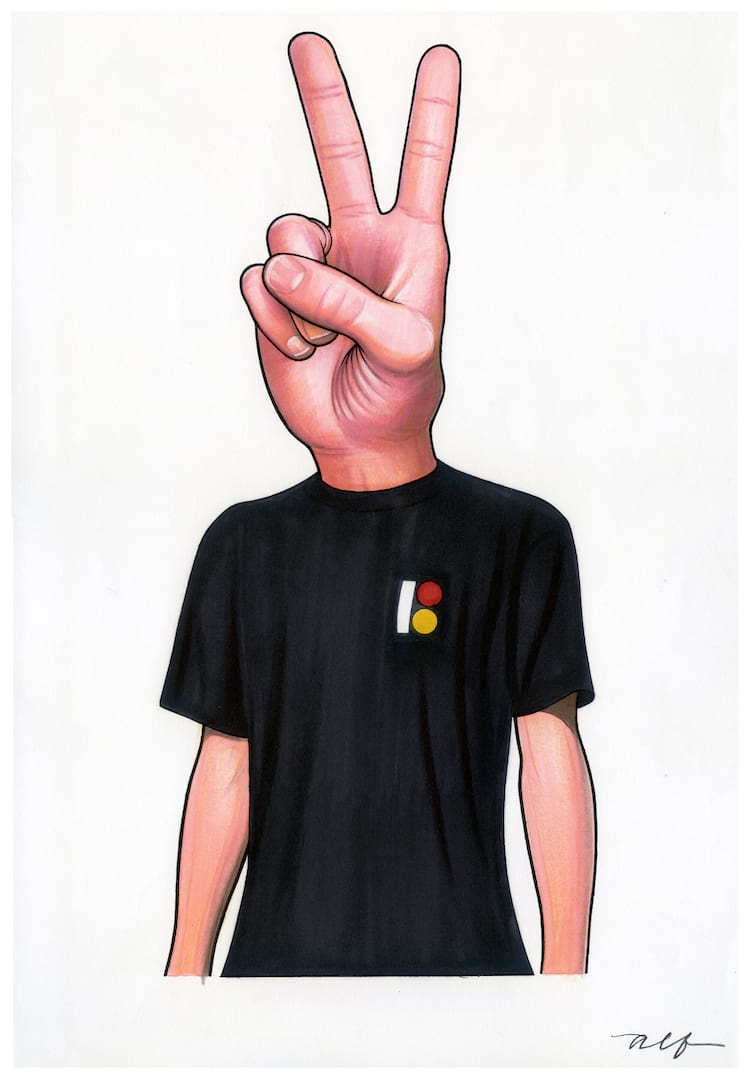
Alf eventually made peace with Plan B
It must be hard for kids to think like, How do I get from here to there? Your journey is probably not repeatable because everything’s changed, but what are some of your habits? What are some things that you do every time there’s been a challenge that you go through that might be helpful to a kid who’s interested in design or art?
I would just say surround yourself by those things that you’re interested in. Like I said, when it comes to me trying to maintain my inspiration for footwear design I look at tons of footwear. I look at tons of architecture and different things. I draw inspiration from different things. It’s just a matter of surrounding yourself with what it is that you like to do. If it’s footwear design, surround yourself with that. Draw a lot; draw footwear; research footwear. I get a lot of DMs from kids who are interested in doing what I do with footwear design and design and they ask me how I do it. I let them know that the beauty of modern technology is that you have a platform nowadays in which to showcase your work. Make good use of that. If you are wanting to be a footwear designer, study footwear design; look at footwear; start drawing shoes; understand as much as you can about it—not only making hand-drawn sketches but learning how to draw in Illustrator. Learn the language that you want to speak. It’s the same thing with graphics. I think the cool thing with my line of work, whether it’s design and graphics, is social media. Being able to explore social media, being able to type in certain hashtags and get inspired. It’s all in the palm of your hand these days. Then also being able to not only get inspired utilizing those platforms but also utilizing them to showcase your work and get it out there. So yeah, practice the trade and learn as much as you can about it. Surround yourself with that information. Teach yourself. Education is always key, right? It’s all at your fingertips these days.
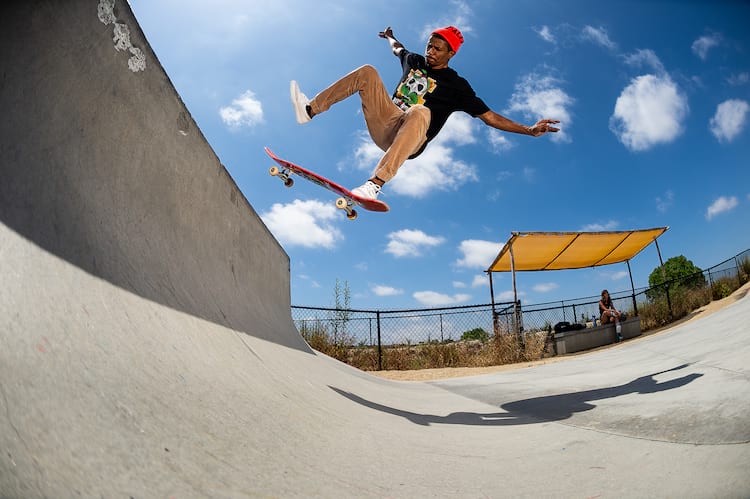 H-Street magic never dies. One-foot to fakie 30 years after Hokus Pokus Photo: Burnett
H-Street magic never dies. One-foot to fakie 30 years after Hokus Pokus Photo: Burnett
For more check @EVERYBODYSKATES and @ALPHONZORAWLS
It must be hard for kids to think like, How do I get from here to there? Your journey is probably not repeatable because everything’s changed, but what are some of your habits? What are some things that you do every time there’s been a challenge that you go through that might be helpful to a kid who’s interested in design or art?
I would just say surround yourself by those things that you’re interested in. Like I said, when it comes to me trying to maintain my inspiration for footwear design I look at tons of footwear. I look at tons of architecture and different things. I draw inspiration from different things. It’s just a matter of surrounding yourself with what it is that you like to do. If it’s footwear design, surround yourself with that. Draw a lot; draw footwear; research footwear. I get a lot of DMs from kids who are interested in doing what I do with footwear design and design and they ask me how I do it. I let them know that the beauty of modern technology is that you have a platform nowadays in which to showcase your work. Make good use of that. If you are wanting to be a footwear designer, study footwear design; look at footwear; start drawing shoes; understand as much as you can about it—not only making hand-drawn sketches but learning how to draw in Illustrator. Learn the language that you want to speak. It’s the same thing with graphics. I think the cool thing with my line of work, whether it’s design and graphics, is social media. Being able to explore social media, being able to type in certain hashtags and get inspired. It’s all in the palm of your hand these days. Then also being able to not only get inspired utilizing those platforms but also utilizing them to showcase your work and get it out there. So yeah, practice the trade and learn as much as you can about it. Surround yourself with that information. Teach yourself. Education is always key, right? It’s all at your fingertips these days.
 H-Street magic never dies. One-foot to fakie 30 years after Hokus Pokus Photo: Burnett
H-Street magic never dies. One-foot to fakie 30 years after Hokus Pokus Photo: BurnettFor more check @EVERYBODYSKATES and @ALPHONZORAWLS
-
10/14/2024
Jamie Thomas' 50th Birthday and War Saw Launch Event Photos
Jamie Thomas celebrated his 50th rip around the sun with the launch of his new shoe operation War Saw. Check the new gear and cheers the Chief to 50 more. -
12/13/2022
The First Abloh Invitational Photos
Atiba set sail for Florida to link with Koston, Ishod, Dashawn, P-Rod and more at the very first Abloh Skateboard Invitational. See how it all went down through the lens of one of our best. -
11/08/2022
Burnout: Cab’s Combi Blowout
Steve Caballero celebrated 30 years of the Half-Cab with a VIP final session at the Combi Pool. Hosoi, Pabich, Lizzie, MacDonald .... who WASN'T there?! -
8/01/2022
FA & Adidas’ “Hollywood Skate Jam” Video
All your favorite non-contest skaters going for broke on a rugged parking lot street course. Watch Berle, Grant, Kirby, Louie, Jake, Tyson and hella more blow minds before the kids go and burn it down. This is skateboarding, fired up! -
8/01/2022
Burnout: EFFING BURNT
FA, Thrasher and the three stripes teamed up for a classic parking lot skate jam. What could possibly go wrong? Burnout, reporting
